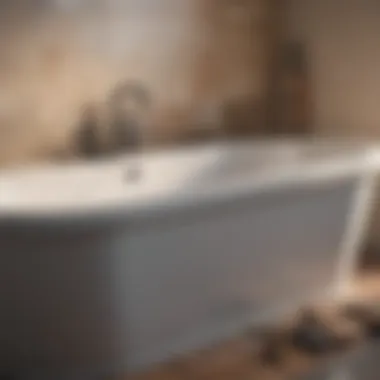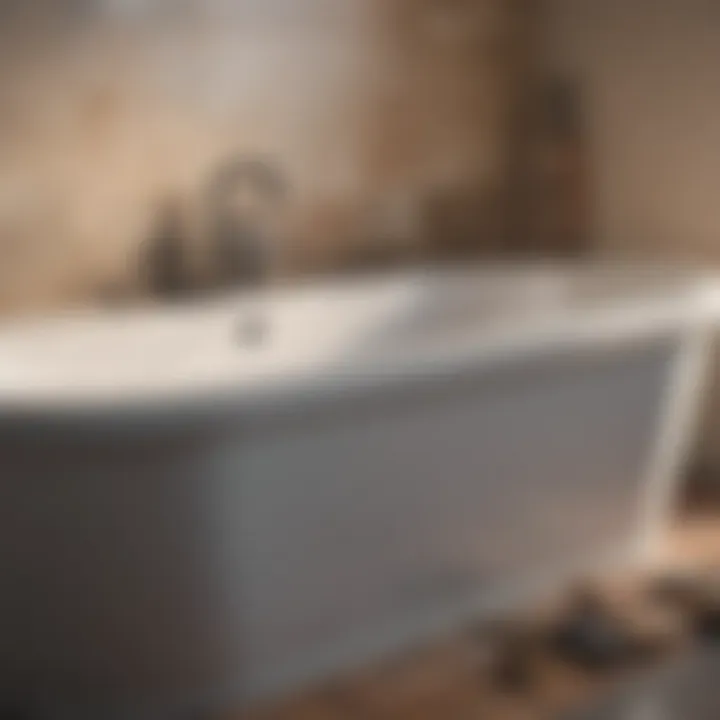Comprehensive Guide on the Cost to Unclog a Bathtub


Intro
Unclogging a bathtub can often seem like a daunting task for homeowners. The challenges are not just technical; they also encompass financial implications that vary widely based on different factors. Understanding these aspects is crucial for making informed decisions about how to proceed. This guide provides a thorough examination of the costs associated with unclogging a bathtub, addressing both DIY methods and professional services. It also discusses potential repairs that might be necessary, ensuring readers grasp all dimensions related to this common household issue.
Factors Influencing Costs
The costs involved in unclogging a bathtub can fluctuate based on various factors. These include:
- Type of Clog: The nature of the blockage directly influences the costs. Hair, soap, or mineral buildup may require less intensive treatment compared to foreign objects or severe pipe damage.
- Location: The geographical area plays a role as well. Urban settings may engage more service options, thereby impacting price.
- Professional vs. DIY: Choosing between a do-it-yourself approach or hiring a professional will significantly alter the financial landscape. DIY methods can save money, but not always guarantee effectiveness.
- Tools and Materials: If opting for DIY, the cost of equipment, such as plungers, plumbing snakes, or chemical drain cleaners, adds to the overall expense. Some products could range from inexpensive to considerably more costly.
DIY Approaches to Unclogging
For those who decide to tackle the problem independently, several methods can be effective. Here are some common DIY strategies:
- Plunger: A standard tool found in many homes. Ensure a proper seal over the drain to create sufficient suction. This often works for minor clogs.
- Baking Soda and Vinegar: An eco-friendly alternative that can dissolve minor blockages. Mix equal parts of both ingredients, pour down the drain, and follow with hot water after a few minutes.
- Plumbing Snake: A more invasive method where a flexible metal rod is used to reach deeper clogs. Knowledge about proper application is crucial to avoid pipe damage.
- Boiling Water: Pouring boiling water down the drain can help dissolve greasy buildups. Repeat several times for stubborn clogs.
Note: While DIY methods can save money, they require caution. Incorrect techniques can lead to further issues, increasing repair costs.
Professional Services
If DIY attempts do not yield results, contacting a professional may be necessary. Professionals generally charge based on the complexity of the situation. Here are some costs associated with hiring an expert:
- Basic Unclogging Services: These typically range from $100 to $250, varying by location and situation.
- Severe Clogs: More complex issues, such as those requiring camera inspections or extensive pipe work, can escalate costs significantly, sometimes exceeding $500.
- Aftercare Maintenance: Post-unclogging services to prevent future issues may also incur extra expenses, albeit these are usually worth considering.
Potential Repairs
In some scenarios, unclogging might reveal underlying issues in plumbing systems. Repairs could consist of:
- Pipe Replacement: If damage is discovered during unclogging, replacing sections of pipe can be necessary.
- Sealants and Patching: Older pipes that have developed cracks may be patched to prolong their life.
- Full System Inspection: A thorough check-up by a professional could uncover other plumbing concerns, ensuring all potential issues are addressed.
The End
Understanding the costs of unclogging a bathtub is essential for homeowners. Weighing the DIY options against professional services, and factoring in potential repairs, helps in making informed decisions. With this comprehensive guide, readers can navigate through the financial landscape associated with unclogging their bathtubs more effectively.
Understanding Bathtub Clogs
Understanding bathtub clogs is foundational to tackling the financial implications and solutions that come with them. Clogs in a bathtub may seem like a minor inconvenience initially, but they can lead to bigger issues if not addressed promptly. Knowing how clogs occur helps homeowners anticipate problems and take preventive measures. This understanding informs decisions about whether to go the DIY route or seek professional assistance.
The implications of ignoring a clog can be significant. Water backing up in a bathtub not only disrupts daily activities but can also raise the risks of mold and damage to plumbing systems. Recognizing potential clog causes early can save you both time and money in the long run. Ultimately, this knowledge acts as a guide to effective unclogging methods while considering the costs involved.
Common Causes of Bathtub Clogs
Bathtub clogs often arise from several common causes. Hair is frequently a major offender, as strands can accumulate in the drain over time, creating a barrier to water flow. Soap scum is another leading cause, as it builds up on the drain’s interior and narrows the passageway.
Other culprits include:


- Foreign Objects: Items like small toys, jewelry, or toiletries can accidentally fall into the bathtub and block the drain.
- Mineral Deposits: Hard water can lead to the buildup of minerals that restrict water flow.
- Tree Roots: In some cases, external factors like tree roots invading underground pipes can lead to severe blockages, affecting the bathtub’s drainage.
Awareness of these causes aids in preventative maintenance and reinforces the importance of regularly checking drains.
Signs of a Clogged Bathtub
Recognizing the signs of a clogged bathtub can prevent exacerbating the issue. Common indicators include:
- Slow Draining: If you notice water pooling in the tub, it is usually the first signal of a clog.
- Unpleasant Odors: Foul smells can arise from trapped water, indicating that something is preventing proper drainage.
- Gurgling Sounds: If you hear gurgling noises when the water drains, air is getting trapped behind a clog.
By being vigilant about these signs, homeowners can address clogs early, potentially avoiding a costly professional service or extensive repairs later.
Estimating the Cost to Unclog a Bathtub
Understanding the costs involved in unclogging a bathtub is crucial for homeowners. This process can sometimes be straightforward but can also turn into a bigger problem. Knowing the costs helps in budgeting appropriately. It's not only about the immediate expense of getting the job done; you also need to consider long-term implications. If you have a handle on these aspects, you can make a more informed decision.
Average Price Range
When thinking about unclogging a bathtub, the average price range varies significantly.
- DIY methods: Minimal cost, often just the price of tools (like a plunger or an auger) or natural remedies (baking soda, vinegar).
- Hiring a plumber: Cost typically falls in the $100 to $400 range. This depends on the severity of the clog and the plumber’s hourly rate.
- Emergency services: When clogs happen after hours or on weekends, the costs can edge higher, often adding 50% or more to standard rates.
The average cost for unclogging a bathtub service usually hovers around $200. This is a important factor when deciding if it’s best to try a DIY approach or engage a professional.
Factors Influencing Cost
Multiple factors affect the cost of unclogging a bathtub, making it essential to understand what influences pricing before getting a service.
- Type of clog: Some clogs are simple to clear, while others may involve invasive measures like disassembling pipes.
- Location: Prices vary by region. Urban areas tend to have higher service rates compared to rural areas due to demand and cost of living.
- Time of service: As previously mentioned, services required during off-hours can double or triple the cost.
- Professional qualifications: Hiring a certified plumber with experience may cost more than others, but their expertise can prevent future issues.
- Additional services: If the initial assessment reveals other plumbing problems, costs can rise. Inspections, repairs, and maintenance may be included in the final bill.
- Hair and soap scum buildup is often easier and less costly to handle.
- Tree roots or deeper plumbing issues can cause higher costs.
Being aware of these various elements will help the homeowner approach the issue of a clogged bathtub with clarity.
DIY Methods for Unclogging
Understanding DIY methods for unclogging a bathtub is crucial for homeowners looking to avoid significant expenses associated with professional services. These techniques not only help save money but also empower individuals to tackle plumbing issues independently. By becoming familiar with various unclogging methods, one can choose the right approach suited to their situation and gain practical skills for future use.
Another benefit of DIY methods is the immediate availability of solutions. When faced with a clog, waiting for a plumber can be inconvenient. Knowing how to resolve the issue quickly can prevent further damage and reduce stress. However, it is essential to consider the severity of the clog and the suitability of each method before proceeding.
Plunger Techniques
Using a plunger is often the first line of defense against a clogged bathtub. The effectiveness of this method relies on creating a vacuum that can dislodge the blockage. To use a plunger efficiently, ensure there is enough water in the tub to cover the plunger cup. This helps achieve a better seal and increases suction.
- Cover the Overflow Drain: Use a wet cloth to block the overflow drain. This ensures that air doesn’t escape and maximizes pressure.
- Position the Plunger: Place the plunger over the drain and push down to create a seal. Move the plunger up and down vigorously for several seconds.
- Check the Drain: After plunging, lift the plunger and see if water drains properly. If it does not, repeat the process or consider another method.


Chemical Drain Cleaners
Chemical drain cleaners provide an alternative for tackling bathtub clogs, especially when physical removal methods are ineffective. These products work by breaking down organic materials and debris that accumulate in pipes. However, caution is necessary when using them. The harsh chemicals can damage pipes if used excessively.
- Read the Instructions: Always follow the manufacturer’s guidelines for effective use. This includes recommended amounts and safety precautions.
- Choose the Right Product: Select a chemical cleaner that is specifically formulated for baths to avoid adverse reactions.
- Protect Yourself: Wear gloves and safety goggles when handling these chemicals to minimize risk of injury.
Natural Remedies
For those who prefer eco-friendly solutions, natural remedies offer a viable option for unclogging bathtubs. Common pantry items like baking soda and vinegar can be effective in breaking down minor blockages while being gentle on pipes.
- Baking Soda and Vinegar: Pour half a cup of baking soda into the drain followed by half a cup of vinegar. Let it sit for about 30 minutes before flushing with hot water.
- Boiling Water: Sometimes, simply pouring boiling water down the drain can help dissolve fats and soap residues. This method works well for minor clogs.
- Salt and Baking Soda: A combination of salt and baking soda (half a cup of each) can also be effective. Follow it up with boiling water for enhanced results.
These DIY methods offer valuable solutions to common bathtub clogs. Always assess the severity of the clog before deciding on the best approach.
When to Hire a Professional
Understanding when to hire a professional plumber can significantly impact both the effectiveness of the unclogging process and the overall costs involved. While many homeowners may feel inclined to tackle the issue themselves, certain situations necessitate the expertise of a skilled professional. This section explores various elements that guide this decision-making process.
Assessing Complexity
Before deciding whether to call in a professional, it is crucial to assess the complexity of the clog.
- Type of Clog: Some clogs may be minor, caused by hair or soap buildup, which can often be resolved with simple DIY methods. On the other hand, if the clog persists despite these efforts, it may indicate a more complicated issue such as:
- Frequency of Clogs: If clogs happen regularly, this may signal underlying problems within your plumbing system that require professional inspection. A single occurrence might be manageable, but recurring blockages often indicate larger issues needing specialized skills.
- Time and Tools: The availability of time and proper tools is also crucial. Professionals carry advanced equipment like video cameras to inspect the pipes, as well as effective drain cleaning machines. If a homeowner lacks the needed tools or time to investigate the problem thoroughly, engaging a professional proves beneficial.
- Tree roots infiltrating the pipes.
- A collapsed or damaged pipe.
- Issues deeper within the plumbing system.
Cost Analysis of Hiring Professionals
Hiring a professional comes with its own cost considerations. Many homeowners often fear the potential expense, yet understanding the payments involved can guide better decisions.
- Average Fees: The cost of hiring a plumber to unclog a bathtub can range widely, from $100 to $400, depending on various factors. This includes:
- Long-term Value: While the immediate expense may seem daunting, utilizing a professional's services can save money over time. They can help prevent future issues, offering recommendations for maintaining your plumbing system. Regular maintenance may avert more severe clogs, leading to greater savings associated with potential emergency repairs.
- Service Call Fees: Most companies charge a fee just to send a technician to your home. This could be from $50 to $100, varying by location and company.
- Hourly Rates: The cost of labor per hour typically falls between $50 and $150. Complex jobs demand more time, directly influencing this aspect of the price.
- Additional Charges: If plumbing parts must be replaced or exceptional methods are required, this will increase the overall price. For example, camera inspections or hydro-jetting can add significant additional fees, potentially enhancing the total bill by dozens or even hundreds of dollars.
It is essential to weigh the costs involved with hiring a professional against the potential risks and future complications of DIY attempts.
Additional Costs to Consider
When discussing the expenses associated with unclogging a bathtub, it is crucial to factor in additional costs that may arise during the process. These costs can influence your overall budget and should not be overlooked. Homeowners must be aware of these potential expenses that extend beyond just the immediate cost of unclogging. This section will delve into specific elements to consider, benefits of understanding these costs, and considerations that can guide decision-making.
Potential Repairs from Clogs
Clogs can lead to more than just inconvenience; they may result in significant repairs. Ignoring a simple blockage may cause subsequent issues like leaks or damage to plumbing systems. This can incur costs that far exceed those needed for immediate unclogging. Here are some repairs to be aware of:
- Pipe Damage: If clogs are persistent, the pressure build-up can lead to cracks or breaks in pipes. Repairing these damages can be costly, especially if it requires extensive work beneath floors or behind walls.
- Water Damage: A clogged bathtub can overflow or leak, damaging floors or surrounding areas. This may need repairs such as replacing tiles, plywood, or drywall, each presenting its own expense.
- Drain System Issues: Over time, frequent clogs may indicate a more systemic issue within the drain's structure, such as tree roots encroaching or broken sections. Addressing these may require more than just unclogging.


Being aware of these potential repairs can help homeowners make informed choices about both DIY and professional unclogging options, ensuring that short-term savings do not lead to long-term financial drain.
Long-term Maintenance Costs
Understanding the long-term maintenance costs is essential to prevent future clogs. Keeping your bathtub drain clear may save you from repeated expenses.
Regular upkeep can significantly reduce the likelihood of clogs and resultant repairs. Here are some costs associated with long-term maintenance:
- Regular Professional Inspections: Engaging a plumber for periodic inspections can identify issues before they escalate. This might be a small recurring cost but often prevents larger future repairs.
- Preventative Treatments: Depending on your plumbing system, you might consider periodic treatments with safe chemicals or enzymatic cleaners to reduce build-up. Investing in these products can be more cost-effective than dealing with major clogs.
- Upgrading Fixtures: Sometimes, older fixtures may be the primary cause of persistent clogs. Replacing them with modern, more efficient options can reduce clogs and need for service.
In summary, while unclogging a bathtub may seem straightforward, taking into account potential repairs and long-term maintenance costs is necessary. This awareness can protect your financial health and ensure peace of mind in your home's upkeep.
Preventative Measures to Avoid Clogs
Preventative measures are essential to avoid the inconvenience and costs associated with clogged bathtubs. Taking proactive steps can save time, effort, and money. Understanding how clogs occur helps to implement methods that will minimize their likelihood. By adopting simple strategies, homeowners can maintain the integrity of their bathtubs and plumbing systems.
Regular Maintenance Tips
Regular maintenance is a cornerstone in preventing bathtub clogs. A few straightforward actions can significantly reduce the risk of buildup in your pipes. Here are some effective maintenance tips:
- Routine Cleaning: Clean the bathtub and drain regularly to remove hair, soap residue, and other debris. A mixture of vinegar and baking soda can be effective for this purpose.
- Use Strainers: Installing a drain strainer can capture hair and larger particles. Regularly emptying the strainer will prevent many clogs.
- Check for Leaks: Regularly inspect the plumbing for leaks or signs of wear. Early detection can prevent larger plumbing issues.
- Flush the Drains: Flushing the drains with hot water at least once a month can help dissolve soap and prevent buildup.
- Educate Family Members: Informing everyone in the household about these preventive measures can enhance efforts to maintain a clog-free bathtub.
Proper Disposal Techniques
Proper disposal techniques are crucial for keeping bathtubs clear of debris. Many common household items can cause buildup if not disposed of correctly. Here are simple disposal tips:
- Avoid Flushing Unusual Items: Never flush items such as wipes, cotton balls, or menstrual products. These can accumulate and cause serious clogs.
- Dispose of Hair Properly: After showering, it's essential to collect loose hair and dispose of it in a waste bin rather than down the drain.
- Be Cautious with Oils and Grease: If using products with oils or grease, avoid rinsing them down the drain. Instead, let them solidify and throw them away with the trash.
Regular preventive practices not only extend the life of your plumbing system but also enhance the overall hygiene of your bathing space.
Implementing these preventative measures can lead to fewer clogs and increased satisfaction with your bathtub. By dedicating effort to these tasks, homeowners can enjoy their baths without the concern of unexpected blockages.
Finale
Understanding the costs associated with unclogging a bathtub is fundamental for homeowners. This comprehension aids in making informed decisions when faced with plumbing issues. It is not just about resolving a clogged drain; it encompasses a wider range of financial implications, including potential repairs or professional services.
Summarizing Options and Costs
Throughout this article, we have explored various options for unclogging bathtubs. DIY methods provide a cost-effective solution but require time and effort, while hiring a professional ensures the job is done correctly, albeit at a higher expense. The average costs fluctuate based on several factors, including location and the specific nature of the clog. Some key considerations include:
- DIY Approaches: Typically range from $10 to $50, involving simple tools and household products.
- Professional Services: Costs can vary widely, approximately $100 to $300 depending on the complexity of the clog and the technician's hourly rate.
- Potential Repairs: In some cases, you may face additional costs if there is damage caused by severe clogs, which may lead to plumbing repairs or replacements.
"An ounce of prevention is worth a pound of cure."
Final Recommendations
To navigate the complexities of bathroom drainage issues, take a proactive stance. Regular maintenance checks can minimize the risk of severe clogs. Here are some final recommendations:
- Educate yourself on common causes: Awareness can prevent future mishaps.
- Regularly use preventative measures: Monthly maintenance can save costs in the long run.
- Weigh your options carefully: Decide between DIY solutions and professional help based on the situation at hand.
Ultimately, being well-informed about the costs and strategies for unclogging bathtubs empowers homeowners. Make strategic choices to maintain both functionality and budget.



